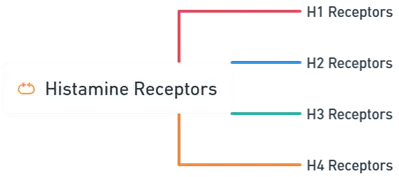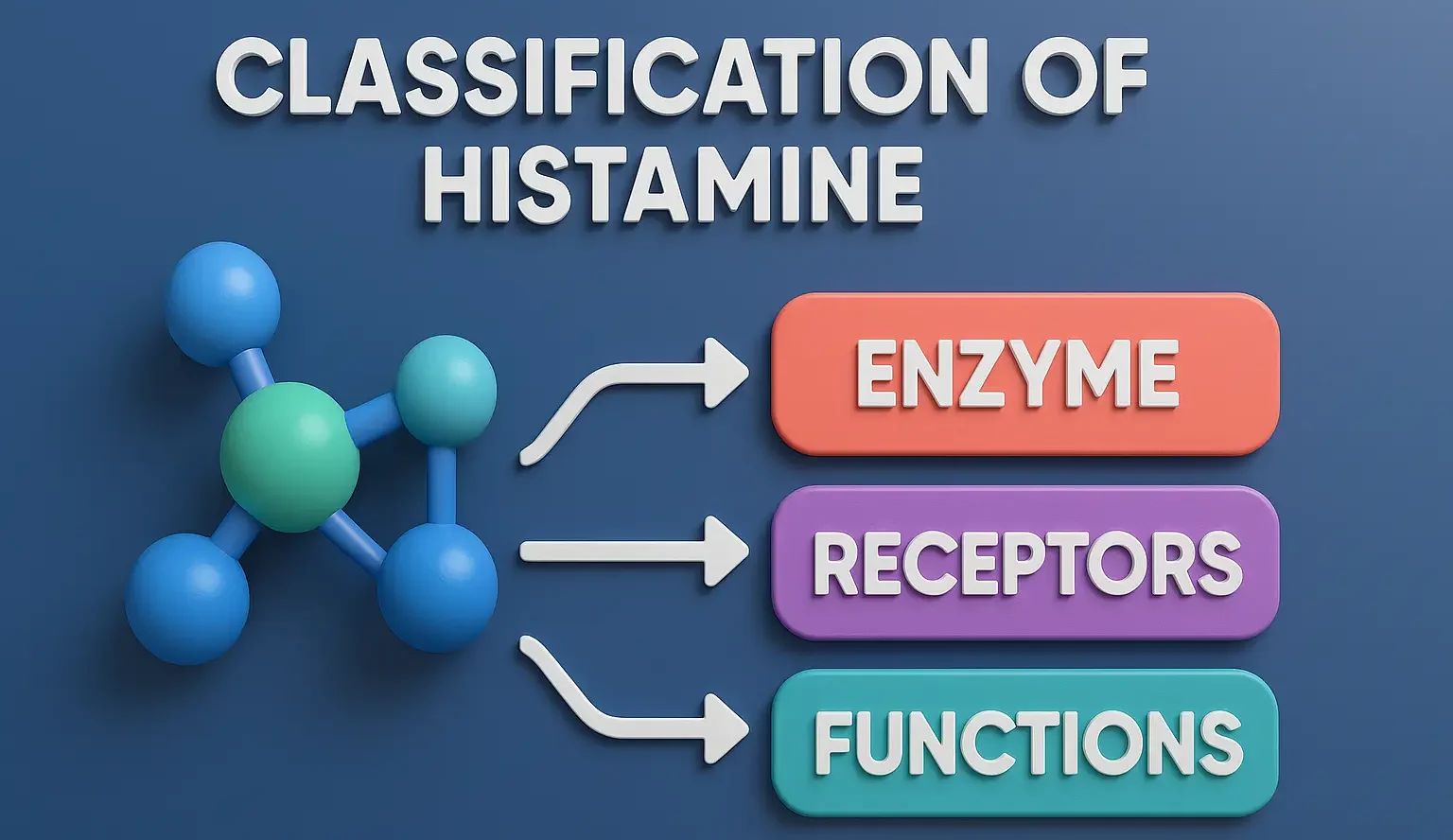- Classification of Histamine: Based on receptor types—H1, H2, H3, and H4
- Classification of Histamine: Involved in allergy, gastric acid, CNS, and immunity.
- Histamine is a biogenic amine derived from the decarboxylation of the amino acid histidine.
- It plays pivotal roles in immune responses, gastric acid secretion, and as a neurotransmitter.

Synthesis:
- From the amino acid histidine by the enzyme histidine decarboxylase.
Storage:
- Primarily stored in mast cells (in tissues) and basophils (in blood). Also found in the brain as a neurotransmitter.
Release Triggers:
- Allergic reactions (type I hypersensitivity reactions).
- Tissue injury or mechanical trauma.
- Certain drugs and chemicals.
Functions of Histamine:
- Immune Response: Mediates inflammation and allergic reactions by increasing vascular permeability and attracting immune cells.
- Gastric Secretion: Stimulates parietal cells in the stomach to produce hydrochloric acid.
- Neurotransmission: Involved in wakefulness and cognitive functions.
Histamine Receptors:
- Histamine exerts its effects through four types of receptors, designated H1 to H4, each with distinct locations and functions.

-
H1 Receptors:
- Location: Smooth muscles, endothelium, central nervous system.
- Functions: Mediate allergic symptoms (e.g., vasodilation, bronchoconstriction), contribute to wakefulness.
-
H2 Receptors:
- Location: Parietal cells of the stomach, heart.
- Functions: Stimulate gastric acid secretion, regulate heart rate.
-
H3 Receptors:
- Location: Central nervous system, presynaptic neurons.
- Functions: Modulate neurotransmitter release.
-
H4 Receptors:
- Location: Bone marrow and white blood cells.
- Functions: Involved in immune cell chemotaxis and activation.
Pharmacological Effects of Histamine
- Vasodilation, particularly of small vessels → decreases blood pressure.
- Increased capillary permeability → edema and urticaria.
- Smooth muscle contraction → bronchoconstriction (H1 effect).
- Gastric acid secretion (H2 effect).
Histamine Antagonists

-
H1 Antagonists (H1 Blockers):
- Purpose: Primarily used to treat allergic reactions, such as hay fever, urticaria, and allergic conjunctivitis.
- Examples: Diphenhydramine, cetirizine, loratadine.
- Mechanism: Block H1 receptors to reduce vasodilation, capillary permeability, and smooth muscle contraction associated with allergic responses.
-
H2 Antagonists (H2 Blockers):
- Purpose: Used to reduce gastric acid secretion in conditions like peptic ulcers and gastroesophageal reflux disease (GERD).
- Examples: Ranitidine (withdrawn in many markets due to safety concerns), famotidine, cimetidine.
- Mechanism: Block H2 receptors on parietal cells, decreasing the production of stomach acid.
-
H3 and H4 Antagonists:
- Current Status: Primarily under research; potential applications in neurological disorders and immune modulation.
Below is a concise table summarizing the four histamine receptor subtypes.
| Receptor | Location | Signaling Pathway | Key Effects (Actions) | Example Drug (Typically an Antagonist) |
| H1 | Smooth muscle (bronchi, gut), endothelium, brain | Gq → ↑ IP3, DAG | – Bronchoconstriction – Vasodilation (via NO release) – ↑ Vascular permeability – Itching, pain (nerve endings) |
Diphenhydramine (1st-gen H1 blocker) |
| H2 | Gastric parietal cells, heart, mast cells, brain | Gs → ↑ cAMP | – ↑ Gastric acid secretion – Positive inotropic & chronotropic effects on the heart |
Ranitidine (H2 blocker) |
| H3 | Presynaptic nerve terminals (mainly in the CNS) | Gi → ↓ cAMP | – Inhibition of histamine release (auto-receptor) – Modulation of neurotransmitter release |
Pitolisant (H3 inverse agonist/antagonist) |
| H4 | Hematopoietic cells (eosinophils, T cells, mast cells) | Gi → ↓ cAMP | – Chemotaxis & inflammation – Role in immune cell activation |
Still under research (no major drug in use) |
Note:
- H1 antagonists (antihistamines) are often used for allergic conditions, motion sickness, etc.
- H2 antagonists are used for peptic ulcers and acid reflux (GERD).
- H3 antagonists/inverse agonists have emerging roles in sleep-wake regulation (e.g., Pitolisant for narcolepsy).
- H4 antagonists are still in experimental stages, mainly targeting inflammatory and immune disorders.

